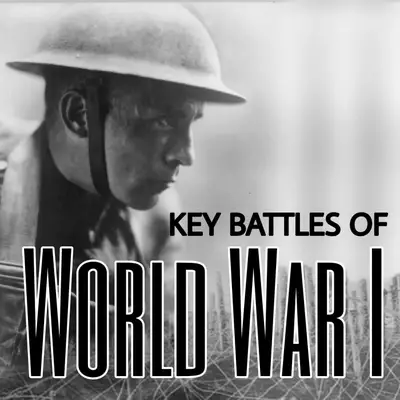
Listen on Your Favorite App
Key Battles of World War One
James Early and Scott Rank
World War One is the watershed moment in modern history. The Western World before it was one of aristocrats, empires, colonies, and optimism for a future of unending progress. After four years of hellish trench warfare, shell fire, 10 million combat deaths, and another 10 million civilian deaths, the world that emerged in 1918 was irrevocably changed. Nation-states came out of the rubble, along with a push for universal rights. New technologies emerged, such as tanks and fighter planes. But something was lost permanently in the Great War: a sense of optimism in mankind. In this series, history professors Scott Rank and James Early look at the 10 key battles that determined the outcome of the war between the Central Powers (Germany, Austria-Hungary, the Ottoman Empire) and the Allies (Britain, France, Russia, United States).
Listen on Your Favorite App

16: The Slog of War -- the Passchendaele Campaign of 1917

December 23, 2020 - 37 min
The best way to describe the Third Ypres (Passchendaele) Campaign of 1917. It’s ‘slog.’ When you think about a drudging act that seems to accomplish nothing, this battle is it. Mud. Mud to your waist. Everything sinks down several feet into mud. Tanks, Cars, guns, horses, everything stuck in mud. Images of a battlefield landscape with pockmarked holes and mist rising from the plains with shattered trees is characterized by the third battle of Ypres.The battle took place on the Western Front from July to November 1917 over control of ridges near the Belgian city of Ypres in West Flanders. Private R.A. Colwell described the scene in 1918 as follows: "There was not a sign of life of any sort. Not a tree, save for a few dead stumps which looked strange in the moonlight. Not a bird, not even a rat or a blade of grass. Nature was as dead as those Canadians whose bodies remained where they had fallen the previous autumn. Death was written large everywhere.”

15: The Russian Revolutions of 1917-1923--A Bigger Threat Than the Kaiser?

December 22, 2020 - 43 min
We’ve looked at many battles in this series, but we’ve only tangentially touched on how this war fundamentally altered European society. The Great War is the watershed between the pre-modern and early modern era. As an example, all we have to do is look at Russia. Before World War One, it was an autocracy, very conservative, very religious, and only a few decades away from serfdom, which the rest of Europe abandoned in the Middle Ages. After the war, it was officially atheistic, communist, rapidly industrializing, and becoming one of two superpowers that dominated the 20th century. To Churchill, the Bolsheviks represented a greater threat to civilized Europe than did the reeking tube and iron shard of the Kaiser’s Reich. Bolshevism, he declared in the House of Commons, was “not a policy; it is a disease. It is not a creed; it is a pestilence.”

14: Why WW1 Was the Graveyard of Empires (Russian, Ottoman, Austro-Hungarian)

December 21, 2020 - 45 min
World War One shattered the empires of Russia, the Ottomans, and the Austro-Hungarians, which had all existed in one form or another for centuries. That's because it broke the fragile alliances that kept these Empires alive. In this episode, we explore the Southern Fronts of World War One in 1916-1917. Starting with Italy, since Italy’s entry into the war, Italy and Austria had fought several battles along their border in the Alps. Neither side was able to make headway until May 1916, when Austria launched the “Punishment Expedition,” which pushed the Italian army back. In the winter of 1915-16, the Serbian army, with many civilians along fled Serbia into the mountains of Albania toward the coast. 200,000 died along the way. By mid-January 1916, the Allies were taking thousands from the Albanian coast to the Greek island of Corfu. Also in January, Austria-Hungary invaded Montenegro. Within 2 weeks, the government surrendered, although the army retreated into Albania. The Austrians followed them there, occupying Albania. Things were no better in the Ottoman Empire. It was due to divisions between its Turkish-speaking populations and Arabic-speaking populations. The same centrifugal forces that pulled apart the Austro-Hungarian empire were affecting the Ottoman Empire.

13: The Battle of the Somme Caused 1 Million Casualties But Was a Turning Point for WW1

December 20, 2020 - 46 min
The 1916 Battle of the Somme caused a total of 1 million casualties on all sides. the total is over a million casualties. The Allies had gained very little ground. At the end of the battle, they had gained only 7 miles and were still about 3 miles short of their goal from the first day of the war. The Somme, along with Verdun and the Brusilov Offensive, were among the bloodiest in world history up to that point. According to John Keegan, the Battle of the Somme was the greatest British tragedy of the twentieth century: “The Somme marked the end of an age of vital optimism in British life that has never been recovered.” For many, the battle exemplified the ‘futile’ slaughter and military incompetence of the First World War. Yet a more professional and effective army emerged from the battle. And the tactics developed there, including the use of tanks and creeping barrages, laid some of the foundations of the Allies’ successes in 1918. The Somme also succeeded in relieving the pressure on the French at Verdun. Abandoning them would have greatly tested the unity of the Entente. One German officer described the Battle of the Somme as ‘the muddy grave of the German Field Army’. That army never fully recovered from the loss of so many experienced junior and non-commissioned officers.

12: The Flying Aces of World War One

December 19, 2020 - 41 min
Since the first successful flight of an airplane, people had imagined and dreamed of airplanes being used for combat. H. G. Wells's 1908 book (The War in the Air was an example. When World War One broke out, there were only about 1000 planes on all sides. Planes were very basic. Cockpits were open, instruments were rudimentary, and there were no navigational aids. Pilots had to use maps, which were not always reliable. Getting lost was common. Sometimes pilots had to land and ask directions! At the beginning of the war, airplanes were seen as being almost exclusively for reconnaissance, taking the job formerly done by cavalry. Eventually, however, it became necessary for planes to eliminate the observation planes of the enemy, so air-to-air combat (dogfights) became common.

10: WW1 At Sea: The Battle of Jutland (1916)

December 17, 2020 - 54 min
Although overlooked today, the war at sea was a crucial part of World War I overall. The German use of the Unrestricted Submarine Warfare (in which non-military ships could be blown up by submarines without the latter surfacing, making it impossible for innocent men, women, and children to abandon ship) against commerce not only threatened the Allied war effort, but also drew the United States into the conflict. In addition, the British economic blockade of Germany afforded by the Royal Navy’s command of the sea inflicted great damage on the war effort of Germany. Finally, the naval war held great ramifications for the future since many practices employed in the First World War were those pursued in the Second World War.

9: Verdun - The 299-Day Battle That Killed 300K Soldiers And Still Scars The Earth With Unexploded Shells

December 16, 2020 - 48 min
The Battle of Verdun--fought from February 21-December 18 1916 in the Western Front of France--was horrifying and hellish even by the standards of World War One. Over a 299-day-period, there were 1 million total casualties. The French were bled white, but so were the Germans.Of these, 300,000 were killed, which is about 1 death for every minute of the battle. The French most likely lost slightly more than the Germans. About 10% of all French war dead were from Verdun. Half of Frenchmen between 20 and 30 years old were killed. Although more men died at the Somme, the proportion of casualties suffered to the number of men who fought was much higher at Verdun than at any other battle in World War I. Also the number killed per square mile was the greatest at Verdun. To this day, the battlefield is still cratered and pockmarks. Many unexploded shells (maybe 12 million) still remain. Trenches can still be seen. Alistair Horne said, “Verdun was the First World War in microcosm; an intensification of all its horrors and glories, courage and futility.”

8: How 1915 Became World War One's Year of Poison Gas, Genocide, and Millions of Refugees

December 15, 2020 - 43 min
In 1915, the Central Powers and Allies dug in their heels and tried desperately to break the stalemate of the war, still hoping for a short conflict on the scale of a few months. Poison gas was used for the first time. Germans experimented with flamethrowers and armored shields, while the French began using hand grenades. In April, Germans began the Second Battle of Ypres and used 168 tons of chlorine gas. On the Eastern Front, Austria launched three offensives against Russian forces in the Carpathians. All three failed miserably. As many as 100,000 Austrian soldiers froze to death. Further north, Russian forces began to retreat from Warsaw and Riga. In Poland, Russian forces adopted a “scorched earth policy.” They forced Poles and other residents of Poland and western Russia to burn their crops and abandon their homes. This created millions of refugees. In December, the remains of the Serbian Army, along with several hundred thousand civilians, fled through the freezing mountains of Montenegro and Albania to the coast. 200,000 died along the way (out of 700,000 initially). Finally, the Ottomans began the forced deportation of Armenians to Syria, which was actually a death march. It became known as the Armenian Genocide in which 1.5 million were slaughtered.

7: The Battle of Gallipoli (1915) How Ataturk and the Ottomans Hurled the Allies (Including Winston Churchill) Into the Sea

December 14, 2020 - 45 min
The Allies desperately wanted to take control of the Dardanelles (the straights connecting Constantinople with the Mediterranean). They were crucial to Russia and would make it possible for Russia to (in effect) have a warm-water port. The only problem is the Ottomans had controlled the Dardanelles for five centuries and were backed by Germany and the rest of the Central Powers. The Allies wanted to open the Dardanelles, open a second front against Austria, take Constantinople, and knock the Ottomans out of the war. One of the British leaders who championed the plan was Winston Churchill (First Lord of the Admiralty). The Ottomans were led at Gallipoli by a brilliant colonel named Mustafa Kemal. He would win an incredible victory for the Ottomans, save the empire from complete destruction, and keep them in the war for three more years. In 1922-23, he would fight and win the Turkish War of Independence, become the first president of the Republic of Turkey, and become one of the most influential statesmen of the 20th century.
Meet Your Hosts

Meet Your Hosts
James is an Adjunct Professor of History at San Jacinto College in Pasadena, TX. He has published one book and two scholarly articles. He is also the cohost (with Scott Rank) of the Presidential Fight Club, Key Battles of the Civil War, Key Battles of the Revolutionary War, and Key Battles of World War I podcasts.

Meet Your Hosts
Scott Rank is the host of the History Unplugged Podcast and a PhD in history who specialized in the Ottoman Empire and modern Turkey. Before going down the academic route he worked as a journalist in Istanbul. He has written 12 history books on topics ranging from lost Bronze Age civilizations to the Age of Discovery. Some of his books include The Age of Illumination: Science, Technology, and Reason in the Middle Ages and History’s 9 Most Insane Rulers.. Learn more about him by going to scottrankphd.com.